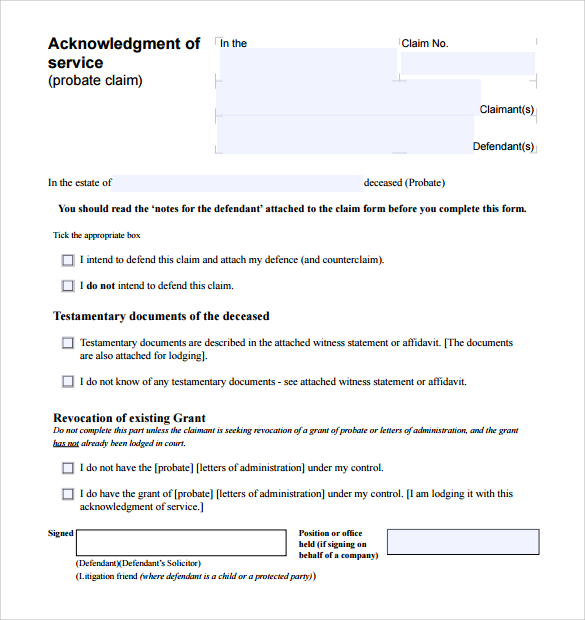Acknowledgement Of Service Form D10 Pdf To Jpg
Defense Security Service. Industrial Security Field Operations. Office of the Designated Approving Authority. Manual for the Certification and Accreditation of Classified. Systems under the NISPOM. November 15, 2013. This form must be attached to EITHER: an Affidavit of Service by Post (Divorce). OR both an Affidavit of Service by Hand (Divorce) and. Affidavit Proving Signature (Divorce). I acknowledge service of the documents named in question 4 above. ANNEXURE NOTE — Witness to complete.Missing.
Step 3) Respondent receives and returns divorce documents The court sends some paperwork to your spouse (the respondent) to inform them that you have applied for a divorce and to request their approval to the divorce proceeding uncontested. The respondent is expected to respond to the court within 8 days. Process Diagram Around a week after the court receives your correctly completed Divorce Petition, the court will send a package of documents to the respondent. The court posts a pack of documents about the divorce to your spouse The documents will be posted to your spouse at the address that you provided on the petition. The package will include these documents: Form D9H Notice of issue of Petition.
This just informs the respondnet that a divorce has been applied for by the petitioner. Keep this copy.
Microsoft Works Download Gratis Italiano Inglese. A copy of the application for divorce (also known as the Divorce Petition). Form D10 The Acknowledgement of Service form for them to complete, sign and return. Send this back.
Within 8 days the respondent is expected to return the Acknowledgement of Service form to the court. Y our spouse completes, signs and returns the D10 form to the court The respondent should return the D10 within 8 days though it is not uncommon for it to take a little longer (a couple of weeks). The package will include these documents: D10 The completed and signed Acknowledgement of Service form.
Instructions for the Respondent The Respondent must acknowledge receipt of the petition by completing and sending (to the court and the petitioner) the acknowledgement of service form they have been sent. The main decisions at this point are: 1) Do you accept that the divorce should go ahead? Or do you wish to defend (prevent) the divorce?
It is unusual to defend the divorce as once one party has reached the point of petitioning there is little the other party can do to prevent the inevitable breakdown of the marriage. 2) Do you accept the grounds (reasons given) for the divorce? It is not uncommon for the respondent to object to the grounds given on the petition. However unless you have a very strong objection then in practical terms it is usual to not take the grounds to personally and to leave them as stated and get on with the process.

3) Are you prepared to accept and pay for the costs of the divorce? The general principles as to the costs of an undefended divorce are as follows – It is common for the petitioner to include a claim for costs in the divorce petition. Sometimes the claim is expressed to be effective only if the petition is defended. The respondent must use the Acknowledgement of Service to indicate whether a claim is accepted or disputed or limited to a specific amount. If the respondent rejects the claim for costs the petitioner must state in the affidavit in support of petition whether or not the claim is pursued. If the petitioner progresses the claim the judge will usually invite the respondent to attend the pronouncement of decree nisi to argue the point.
If this is a significant issue the hearing may be adjourned to be dealt with when there is more time available. The costs in issue in the divorce proceedings are just the costs in relation to the divorce itself and not any correspondence concerning financial issues or children issues.
It is unusual for the costs of an undefended divorce to exceed £800 and is often less. Once you have decided on each of the above three items, then you complete and return (to the court) the acknowledgement of service.
Forms (these will be sent to the respondent by the court) The application for divorce (also known as the Divorce Petition). D10 The completed and signed Acknowledgement of Service form. This is not available to download as you should use the one sent by the court. Frequently Asked Questions: Should I defend the petition?
The main reason to defend the petition is if you do not wish the divorce to go ahead, or if you strongly object to the reasons (grounds) given by your partner. I am not happy to accept the ‘unreasonable behaviour’ grounds, What do I do? If you accept that divorce is inevitable, there is little point in fighting the divorce petition, even if you disagree with some of the ‘unreasonable behaviour’ cited. Courts will these days accept grounds which are less confrontational (such as workaholic, or lack of attention) so there really is no need to list exaggerated/extreme behaviour. You could negotiate with your ex for her to amend the petition to list behaviour examples that you find “acceptable”. My new partner has been listed as co-respondent, what does this mean?
In adultery cases the petitioner can either say the adultery occurred with an un-named person or they can name the person as a co-respondent. (This is less common these days as it causes friction and serves little practical purpose).
It doesn’t have a great impact on the process or the finances. The court is really only concerned with the parties to the marriage.